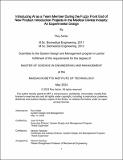Introducing AI as a Team Member During the Fuzzy Front End of New Product Introduction Projects in the Medical Device Industry: An Experimental Design
Author(s)
Asher, Roy
DownloadThesis PDF (4.299Mb)
Advisor
Rubin, Joan S.
Vazquez, Ignacio
Terms of use
Metadata
Show full item recordAbstract
Artificial Intelligence has been around since the 1950s. More recently, with the introduction of advanced machine learning methods, the markets have seen many complex AI solutions that can interact with humans seemingly naturally. Furthermore, the multiplication rate of these technologies is accelerating, and new promises are being marketed daily in every media outlet. In light of this fast technological expansion, there is a need for additional research to evaluate these types of solutions.
This study focuses on the medical device industry. Industries that are highly regulated, like the healthcare technology space, are specifically interesting as they must comply with strict requirements imposed due to the industry's risky nature. The study aims to see how introducing AI as an expert research and development team member at the early phase of a new product introduction medical device project affects a medical device R&D team’s capability to implement scope effectively and efficiently.
The experimental design starts with identifying barriers to team performance from literature and through interviews with seasoned industry leaders in medical devices. A battery of experiments is designed to provide a more complete assessment of the effects of AI as a team member on an R&D team in the medical device industry, as AI expertise in one area can be more impactful than in another. This also ensures an understanding of how our stakeholders' various areas of interest will be affected so that AI can drive value as a team member. The study evaluates and anchors many architectural aspects of experimental design. Clear hypotheses are provided in a format that promotes insightful statistical analysis. A medical device challenge is presented as a game for teams to participate in. Protocols detail preparing for and executing the experiments as well as the post-analysis.
Through this systematic design, the work identifies and explores the complexity of executing the experiments. Implementing the guidance toward study execution and executing these experiments is a natural continuation of this work. Furthermore, the study design lays a foundation for further research in the sociotechnical integration between AI and humans.
Date issued
2024-05Department
System Design and Management Program.Publisher
Massachusetts Institute of Technology